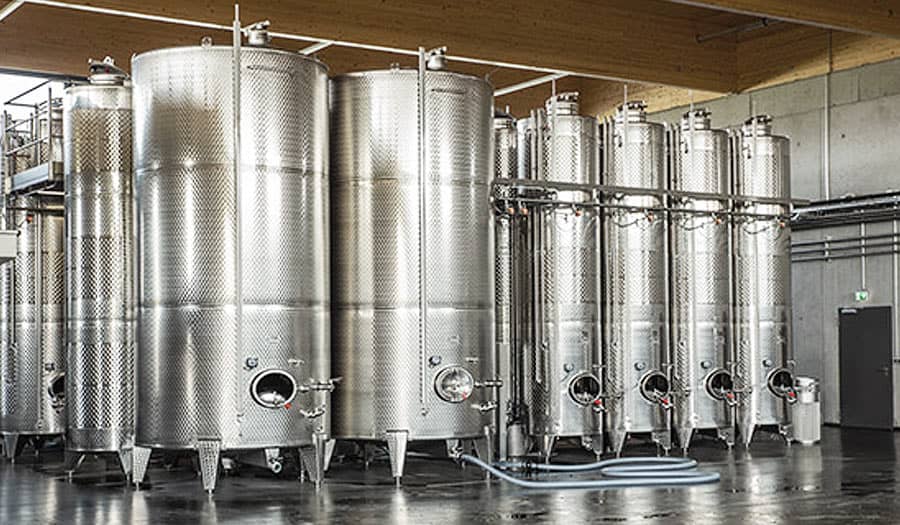適切なワイン発酵タンクを選ぶには、いくつかの要因がある。ブドウからワイン造りを始めるとき、最初に決める重要なことの1つは、発酵容器として何を使うかということだ。一般的な選択肢としては、プラスチック製の樽やプラスチック製の箱、ガラス製やプラスチック製のカーボーイ、ステンレス製のタンクや樽、伝統的なオーク樽などがある。発酵容器の違いは、ワインのスタイルや味に影響する。
種類 ワイン発酵タンク
プラスチックバケツ
プラスチック製発酵タンクは安価で軽量なオプションだが、BPAフリーの食品用プラスチックであることを確認すること。プラスチック製発酵タンクは上部が開いているため、手が届きやすく、ザラメの蓋を簡単に割ることができる。発酵タンクには蓋と発酵ロックが付いているものもあり、赤ワインと白ワインの両方の発酵に使える。ただし、プラスチックは傷がつきやすいので、発酵タンクの洗浄には注意が必要です。バクテリアによる腐敗も考慮する必要がある。酸素に過度にさらされると、発酵中のブドウ果汁に腐敗微生物が混入する可能性がある。汎用性の高い発酵タンクを探しているが、高価なものは買えないという方は、プラスチック製バケツやプラスチック製ボックスを検討してみてください。

ガラス瓶
ほとんどのワイナリーは貯蔵や輸送にガラスを使用していますが、一次発酵の容器としても最適です。ガラスは不活性で、ワインメーカーが発酵プロセスをよりコントロールできるため、素晴らしい素材です。また、表面が滑らかなので洗浄も比較的簡単です。酸化を防ぐために、ガラス瓶に発酵ロックやゴム栓を入れることができる。サイズも小さめなので、冷蔵庫に入れて温度管理もしやすい。欠点は、ぶつけると割れること、光を通すこと、サイズが限られていることだ。
カーボーイは白ワインの発酵には最適な容器ですが、ネックが狭いため赤ワインの発酵には適していません。カーボーイ 小規模または個人的なワイン醸造によく使われる、小さめのガラス容器です。カーボーイには様々な形がありますが、一般的に底が丸く、首が細いため、酸素への暴露を抑えることができます。二次発酵やワインの短期保存によく使われます。
ガラス製カーボーイも細口カーボーイも、ワイン醸造プロセスにおいて幅広い用途があり、具体的な選択は生産規模や個人の好みによる。
ステンレス製発酵タンク
ステンレス・スチール製発酵タンクは、ワイン醸造工程で使用される最も一般的な容器である。1950年代に初めて登場し、ワイン界に旋風を巻き起こした。今日、ワイン醸造工程でステンレス発酵タンクを使用しないワイナリーを見つけるのは難しい。
ステンレス製ワイン発酵タンクは、主に密閉式タンクと開放式タンクの2種類に分けられる。
- 開放式発酵タンク赤ワインの発酵用に特別に設計されたオープントップの発酵タンクは、ブドウの果帽に自由にアクセスでき、ブドウの果帽がタンク内に浸りやすい。広々とした傾斜のある底部は、発酵後の果皮と種子の除去をシームレスかつ容易にします。
- 密閉式発酵タンク:通常、密閉蓋またはゴムパッキンが付いており、発酵中の酸素との接触を効果的にコントロールし、ワインのフルーティーでフレッシュな味わいを維持するのに役立つ。通常、発酵温度を正確に調節するための温度調節装置を備えており、安定した風味を保つ必要のある白ワインや、酸化しやすい赤ワインの生産に適している。
オーク樽
オーク樽はワインの風味とテクスチャーに大きな影響を与える。ワインに複雑なアロマ、味、構造を与えることができる。ワインメーカーがオーク樽を使用する場合(赤ワインの生産では非常に一般的)、酸素をよりゆっくりとワインに取り込むことができる。そのため、これらの容器で醸造されたワインはタンニンが柔らかくなる。オーク樽の焙煎度合いによって、ワインの最終的な風味に影響が出ることがある。オーク樽の大きさは様々で、最小11ガロンから最大250ガロンまである。各サイズのオーク樽は、ワインメーカーのニーズによって用途が異なる。
セラミックポット
セラミック・ポットは、ワイン醸造用の最も古い容器のひとつである。ステンレスや他の素材と比べ、セラミック・ポットは一般的に通気性が良く、発酵中のワインに適度な微小酸素を与えることができる。これにより、発酵と熟成中にワインが呼吸しやすくなり、複雑な風味が生まれる。こうした粘土製の発酵槽は非常に手間がかかるため、広く採用されることはなかった。ワイン生産者たちは、近代的なステンレススティール製の設備を使えば、10倍以上のワインを瓶詰めできると見積もっている。殺菌にも注意が必要だ。粘土の気孔には多くの微生物が生息しているが、容器をお湯ですすぐことはできない。粘土が割れてしまうかもしれない。

なぜコニカル発酵容器を選ぶのか?
酵母収穫の改善
コニカル発酵槽の大きな利点のひとつは、酵母の回収が容易なことである。コニカル発酵槽を使用することで、ワインメーカーは沈殿物を乱すことなく、容器の底から酵母を集めることができる。これにより酵母を再利用することができ、時間と費用を節約することができる。酵母を注意深く回収し再利用することで、醸造家は醸造の一貫性を維持し、望ましい風味を得ることができる。
味と香りを高める。
コニカル発酵槽は、酵母と沈殿物を分離し、よりクリーンで洗練された最終製品を生み出します。発酵中の酵母や沈殿物との接触を最小限に抑えることで、コニカル発酵槽はビールやワインの風味や香りを保ち、より楽しい飲み心地をもたらします。バランスのとれた味わいと心地よい香りが忘れられないビールを味わうことを想像してみてください。これがコニカル発酵槽の魔法なのです。
クリーニングとメンテナンスが容易
円錐形の発酵容器は、洗浄とメンテナンスが容易なように設計されています。先細りの形状は沈殿物やイーストを容易に除去し、洗浄プロセスを簡素化する。さらに、多くの円錐形発酵槽はステンレス製で、耐久性に優れ、滅菌が容易です。つまり、ワイン生産者やワインメーカーは、こすり洗いに費やす時間を減らし、より多くの時間を醸造技術に集中することができる。適切な器具があれば、発酵のための衛生的な環境を維持するのは簡単です。
ワイン発酵容器の正しい選び方とは?
ワイン発酵容器を選ぶ際には、まず生産したいワインの特定のタイプやスタイルのニーズを理解し、予算と生産能力を組み合わせて最適な決定を下すのがベストです。また、ミセ・グループにご連絡いただければ、適切なワイン醸造システムのソリューションをご提供いたします。
- ワインのタイプワインの種類によって、必要な発酵容器が異なる場合がある。例えば白ワインは通常、フルーティーなアロマとクリアな味わいを維持する必要があるため、ステンレス・スティールなど、風味に影響を与えない素材が選ばれることが多い。赤ワインは複雑さと味わいを増すために、木樽や土鍋で供されることもある。
- 材料の検討:コニカル発酵槽は通常、ステンレス製か食品用プラスチック製である。ステンレス製発酵槽は耐久性が高いことで知られ、長期的な投資に適している。また、洗浄も容易で、発酵中の衛生を保つ上で大きな利点となります。さらに、ステンレス製発酵槽は温度管理がしやすく、発酵条件をより正確にコントロールすることができます。
- サイズ容量:適切なサイズは、醸造や醸造のニーズによって異なります。通常使用するバッチサイズを考慮し、必要な容量に対応できる発酵槽を選びましょう。こぼれたり、醸造酒やワインの品質にダメージを与えたりすることなく、発酵プロセスが行われるのに十分なスペースが必要です。また、醸造エリアのスペースも考慮してください。発酵槽が快適に設置でき、発酵プロセス中に簡単にアクセスできることを確認したい。
- 発酵のコントロール:発酵プロセスをどの程度コントロールする必要があるかを検討する。ステンレス・タンクには、発酵温度を正確に制御できる温度制御システムが装備されていることが多い。樽やクレイポットの温度管理は環境条件に左右されることがあり、発酵プロセスや最終的なワインスタイルに影響を与える可能性があります。




